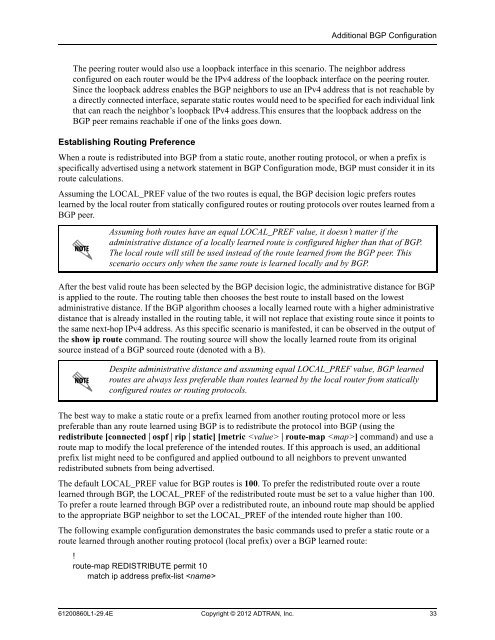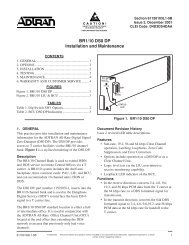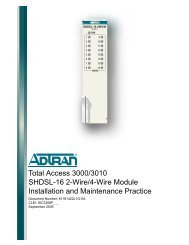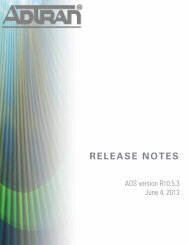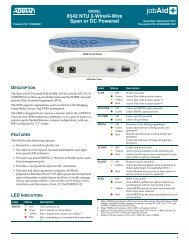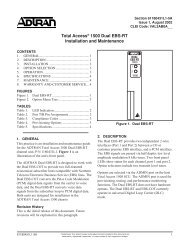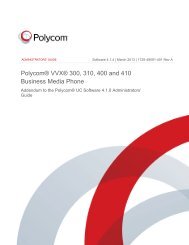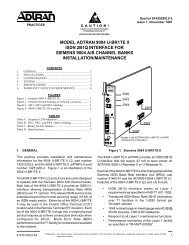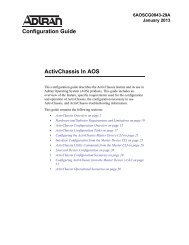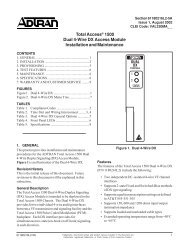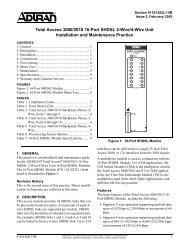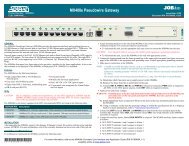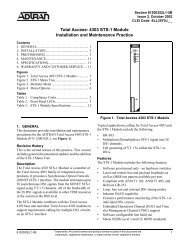View - ADTRAN Support Community
View - ADTRAN Support Community
View - ADTRAN Support Community
Create successful ePaper yourself
Turn your PDF publications into a flip-book with our unique Google optimized e-Paper software.
Additional BGP Configuration<br />
The peering router would also use a loopback interface in this scenario. The neighbor address<br />
configured on each router would be the IPv4 address of the loopback interface on the peering router.<br />
Since the loopback address enables the BGP neighbors to use an IPv4 address that is not reachable by<br />
a directly connected interface, separate static routes would need to be specified for each individual link<br />
that can reach the neighbor’s loopback IPv4 address.This ensures that the loopback address on the<br />
BGP peer remains reachable if one of the links goes down.<br />
Establishing Routing Preference<br />
When a route is redistributed into BGP from a static route, another routing protocol, or when a prefix is<br />
specifically advertised using a network statement in BGP Configuration mode, BGP must consider it in its<br />
route calculations.<br />
Assuming the LOCAL_PREF value of the two routes is equal, the BGP decision logic prefers routes<br />
learned by the local router from statically configured routes or routing protocols over routes learned from a<br />
BGP peer.<br />
Assuming both routes have an equal LOCAL_PREF value, it doesn’t matter if the<br />
administrative distance of a locally learned route is configured higher than that of BGP.<br />
The local route will still be used instead of the route learned from the BGP peer. This<br />
scenario occurs only when the same route is learned locally and by BGP.<br />
After the best valid route has been selected by the BGP decision logic, the administrative distance for BGP<br />
is applied to the route. The routing table then chooses the best route to install based on the lowest<br />
administrative distance. If the BGP algorithm chooses a locally learned route with a higher administrative<br />
distance that is already installed in the routing table, it will not replace that existing route since it points to<br />
the same next-hop IPv4 address. As this specific scenario is manifested, it can be observed in the output of<br />
the show ip route command. The routing source will show the locally learned route from its original<br />
source instead of a BGP sourced route (denoted with a B).<br />
Despite administrative distance and assuming equal LOCAL_PREF value, BGP learned<br />
routes are always less preferable than routes learned by the local router from statically<br />
configured routes or routing protocols.<br />
The best way to make a static route or a prefix learned from another routing protocol more or less<br />
preferable than any route learned using BGP is to redistribute the protocol into BGP (using the<br />
redistribute [connected | ospf | rip | static] [metric | route-map ] command) and use a<br />
route map to modify the local preference of the intended routes. If this approach is used, an additional<br />
prefix list might need to be configured and applied outbound to all neighbors to prevent unwanted<br />
redistributed subnets from being advertised.<br />
The default LOCAL_PREF value for BGP routes is 100. To prefer the redistributed route over a route<br />
learned through BGP, the LOCAL_PREF of the redistributed route must be set to a value higher than 100.<br />
To prefer a route learned through BGP over a redistributed route, an inbound route map should be applied<br />
to the appropriate BGP neighbor to set the LOCAL_PREF of the intended route higher than 100.<br />
The following example configuration demonstrates the basic commands used to prefer a static route or a<br />
route learned through another routing protocol (local prefix) over a BGP learned route:<br />
!<br />
route-map REDISTRIBUTE permit 10<br />
match ip address prefix-list <br />
61200860L1-29.4E Copyright © 2012 <strong>ADTRAN</strong>, Inc. 33


